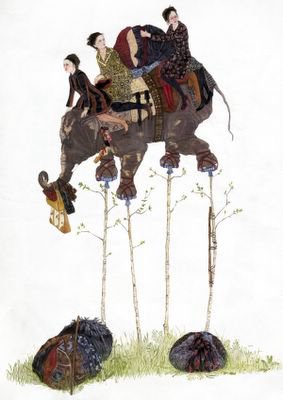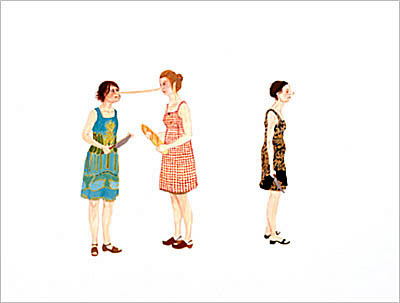"You need to be more contemporary" I was told.
"What is contemporary?" I asked.
Blank stares..humms. Why was I being told to become something if they didn't even know exactly what it was.
"You should look at contemporary artist" I was told.
I told them "I don't really like any contemporary artists, and I have no idea where to start." ...lots of frowns....bad, bad, bad girl I am.
"Read Art Forum."
So I read Art Forum, and was completely lost with the "art speak",jargon, buzz words and the assumption that the reader had been reading art forum for the last thirty years (Remember that awful shirt Greenburg had...remember that dude?). It didn't help.
My First critique at grad school: I put up a bunch of prints
"why are you printmaking..it's obvious you should be doing video."
"You're at grad school, it's time to experiment with new and exciting materials"
"this would translate well into a film, perhaps you could use your prints as a background"
TRANSLATION: Your work sucks
So, I spent the last year or so trying to find a place in the art world that I liked. I still do not know what the big deal was with artists taking photos of the insides of microwaves, and creating grids out of them, or artists socially interacting with people chewing gum and then afterwards, displaying the chewed gum (aren't those teeth marks beautiful?). Still confused, I found this article that was published a year ago. Now it makes better sense. It makes more sense of why I am so confused because the art world is nuts. It's like watching a parasite eat it's host from the inside out. The art world needs to be saved from the crazies.
But, what is this????
Feburary 3, 2005 - The New York Times
Ms. Heiss, director of the P.S. 1 Contemporary ArtCenter in Queens, and Klaus Biesenbach, a curator at P.S. 1 and its big-sister affiliate, the Museum of Modern Art has this to say. "As the world has changed since the last "Greater New York," so have the things artists are thinking about, the curators said. And "there's a lot more elaborate fantasy," Ms.Heiss said. "More storytelling, more science fiction." The projection and video work that so dominated the art scene five years ago has ebbed, she said, while drawing is far more common."
Below is the article on
What is contemporary art?Asking what's wrong with contemporary art begs a more basic question: what is it anyway? Angela Bennie canvasses opinion.
At the Sydney Writers' Festival last month art critic Peter Timms asked: what is wrong with contemporary art? He then attempted an answer. Contemporary art, for the most part, was mere product, made for the arts market - or in response to bureaucratic dogma (the Australia Council's, in particular) or, worse still, to critical theory (French, mostly, but latter-day postmodern theoreticians generally).
Most culpably, it was solipsistic, pursued its own agenda with little regard for or engagement with an audience's need for profound reflection and thought, let alone aesthetic pleasure.
In fact, contemporary art is deliberately "abstruse", Timms said, so that audiences will find it "difficult", and therefore think it clever and profound, when really it is just banal and facile. It achieves its impact and notoriety, not through profundity, but through the hype created by the industry's hangers-on, the "money-changers, hucksters and spruikers".
If the same audience had attended the first round of panel discussions, lectures and symposia accompanying the opening weekend of the 2004 Sydney Biennale they would have thought they were in another city, time and historical epoch. It surely could not be only four weeks later?
For here, the question "what is wrong with contemporary art?" would simply not compute. In this 21st century, in this moment of "contemporaneity" [the new buzz word, we were told], the urgent question was instead: "What is contemporary art?"
Given the extraordinary range of works labelled as contemporary art, it is indeed a fair question. Installations, videos, bodily excretions, ephemera, badly made beds, elephant poo and pigs in aspic join framed oil paintings, etchings, drawings, photographs and sculpture in what Professor Terry Smith of Pittsburgh University called, in his opening address, "the dialogue that is contemporary art".
The 2004 Biennale is buzzing with this chatter. Airplanes made out of clothing, photographs of a woman's glistening cervix, floors spattered with circles of fake hair and boulders smashing cars, all are participants in Smith's dialogue by virtue of the fact that they are "simultaneous to each other and the time they are in".
Biennales, said Smith, were important because they were not so much exhibitions of art works, but a new form of art criticism itself. "They grapple with issues that most traditional art criticism avoids; and they show what art looks like globally in the immediate present. Contemporary art practice is dialogue," said Smith.
Dirk Snawaert, the artistic director of the Museum of Contemporary Art in Lyon, France, speaking in a panel discussion on the future of the museum of contemporary art, took it all a step further.
"Today, art is not the art work any more," he said. "Today art is art practice. It is art-in-process."
Hence a room full of cheeses covered in Band-Aids at the Museum of Contemporary Art, which will, as time goes by, crumble with great pungency into dust. Or the wanderings of Belgian artist Francis Alys and his band of pessimistic volunteers, doomed to travel the streets of Sydney, trying to find a home for one of Alys's sculptural figures. Both the Art Gallery of NSW and the MCA have refused to allow it into their collections: the refusal is integral to the process of Alys's art "work".
"Museums house the relics of the past," said Snawaert. "The future contemporary art museum will have no collections or relics. It will be a space that offers residencies to artists to produce art, rather than a space that houses artworks. The new museum will be a place of production, rather than presentation."
And what of these "producers" of contemporary art, the artists? Is "artist" still a legitimate word in this era of contemporaneity?
In a session which asked if artists could be "created" through education, Professor Su Baker of the Victorian College of the Arts said our art schools were geared to produce "graduates primed to produce works for the market and to create new markets".
Whether they were artists or not, however, only time - in some cases, a long period of time and dedicated work - would tell.
"We see our school as a kind of agency to help students achieve their goals," said Baker. "They do not come to study a particular discipline, but to participate in a culture."
That culture, she said, was not the old-fashioned, hierarchical structure of master/student. "The teacher/student relationship has shifted from hierarchical to a mutually engaging enterprise, where together teacher and student explore the cultural terrain with a spirit of curiosity.
"The model is an active one, not passive. Today the art school is a place that creates a milieu and context for exploration and creativity, not as a place that hands on a prescribed canon of knowledge."
Which brings us back to Peter Timms and his complaint. To ask what is wrong with contemporary art presumes a prior canon of knowledge about what is, and what is not art, and what is good art and what is not - contemporary, modern or any other kind.
In these days of "contemporaneity", it is clear, such a presumption crumbles, like the cheeses at the MCA, pungently and with irrelevancy onto the dust heap of history.
Yeah, baby...take that, and that.....ooooppss did I miss a spot....AND THAT!!!!
















































